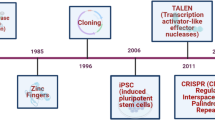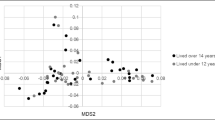Abstract
Chronic pastern dermatitis (CPD), also known as chronic progressive lymphedema (CPL), is a skin disease that affects draft horses. This disease causes painful lower-leg swelling, nodule formation, and skin ulceration, interfering with movement. The aim of this whole-genome scan was to identify quantitative trait loci (QTL) for CPD in German draft horses. We recorded clinical data for CPD in 917 German draft horses and collected blood samples from these horses. Of these 917 horses, 31 paternal half-sib families comprising 378 horses from the breeds Rhenish German, Schleswig, Saxon-Thuringian, and South German were chosen for genotyping. Each half-sib family was constituted by only one draft horse breed. Genotyping was done for 318 polymorphic microsatellites evenly distributed on all equine autosomes and the X chromosome with a mean distance of 7.5 Mb. An across-breed multipoint linkage analysis revealed chromosome-wide significant QTL on horse chromosomes (ECA) 1, 9, 16, and 17. Analyses by breed confirmed the QTL on ECA1 in South German and the QTL on ECA9, 16, and 17 in Saxon-Thuringian draft horses. For the Rhenish German and Schleswig draft horses, additional QTL on ECA4 and 10 and for the South German draft horses an additional QTL on ECA7 were found. This is the first whole-genome scan for CPD in draft horses and it is an important step toward the identification of candidate genes.




Similar content being viewed by others
References
Abecasis GR, Cherny SS, Cookson WO, Cardon LR (2002) Merlin rapid analysis of dense genetic maps using sparse gene flow trees. Nat Genet 30:97–101
Aberle K, Wrede J, Distl O (2004a) Analysis of relationships between German heavy horse breeds based on pedigree information. Berl Münch Tierärztl Wochenschr 117:72–75
Aberle K, Hamann H, Drögemüller C, Distl O (2004b) Genetic diversity in German draught horse breeds compared to a group of primitive, riding and wild horses by means of microsatellite DNA markers. Anim Genet 35:270–277
Chowdhary BP, Raudsepp T, Kata SR, Goh G, Millon LV et al (2003) The first-generation whole-genome radiation hybrid map in the horse identifies conserved segments in human and mouse genomes. Genome Res 13:742–751
De Cock HE, Affolter VK, Wisner ER, Ferraro GL, MacLachlan NJ (2003) Progressive swelling, hyperkeratosis, and fibrosis of distal limbs in Clydesdales, Shires, and Belgian draft horses suggestive of primary lymphedema. Lymphat Res Biol 1:191–199
De Cock HE, Affolter VK, Farver TB, Van Brantegem L, Scheuch B et al (2006) Mearurement of skin desmosine as an indicator of altered cutaneous elastin in draft horses with chronic progressive lymphedema. Lymphat Res Biol 4:67–72
Finnson KW, Tam BY, Liu K, Marcoux A, Lepage P et al (2006) Identification of CD109 as part of the TGF-beta receptor system in human keratinocytes. FASEB J 20:1525–1527
Geburek F, Ohnesorge B, Deegen E, Doeleke R, Hewicker-Trautwein M (2005) Alterations of epidermal proliferation and cytokeratin expression in skin biopsies from heavy draught horses with chronic pastern dermatitis. Vet Dermatol 16:373–384
Kong A, Cox NJ (1997) Allele-sharing models: LOD scores and accurate linkage tests. Am J Hum Genet 61:1179–1188
Kruglyak L, Daly MJ, Reeve-Daly MP, Lander ES (1996) Parametric and nonparametric linkage analysis: a unified multipoint approach. Am J Hum Genet 58:1347–1363
Mittmann EH, Wrede J, Pook J, Distl O (2009) Identification of 21781 equine microsatellites on the horse genome assembly 2.0. Anim Genet. doi:10.1111/j.1365-2052.2009.01979.x
Mömke S, Distl O (2007a) Molecular characterization of the equine ATP2A2 gene. Cytogenet Genome Res 116:256–262
Mömke S, Distl O (2007b) Molecular analysis of the ATP2A2 gene as candidate for chronic pastern dermatitis in German draft horses. J Hered 98:267–271
Penedo MCT, Millon LV, Bernoco D, Bailey E, Binns M et al (2005) International equine gene mapping workshop report: a comprehensive linkage map constructed with data from new markers and by merging four mapping resources. Cytogenet Genome Res 111:5–15
Raudsepp T, Gustafson-Seabury A, Durkin K, Wagner ML, Goh G et al (2008) A 4,103 marker integrated physical and comparative map of the horse genome. Cytogenet Genome Res 122:28–36
Schäper W (1950) Die Verbesserung der Konstitution unserer Haustiere. Z Tierzüchtg Züchtgsbiol 58:1–57
Shimoji T, Murakami K, Sugiyama Y, Matsuda M, Inubushi S et al (2009) Identification of annexin A1 as a novel substrate for E6AP-mediated ubiquitylation. J Cell Biochem 106:1123–1135
Srivastava S, Ko K, Choudhury P, Li Z, Johnson AK, Nadkarni V et al (2006) Phosphatidylinositol-3 phosphatase myotubularin-related protein 6 negatively regulates CD4 T cells. Mol Cell Biol 26:5595–5602
Swinburne JE, Boursnell M, Hill G, Pettitt L, Allen T et al (2006) Single linkage group per chromosome genetic linkage map for the horse, based on two-three-generation, full-sibling, crossbred horse reference families. Genomics 87:1–29
Wallraf A, Hamann H, Deegen E, Ohnesorge B, Distl O (2004a) Analysis of the prevalence of pastern dermatitis in German draft horse breeds. Berl Münch Tierärztl Wochenschr 117:148–152
Wallraf A, Hamann H, Ohnesorge B, Deegen E, Distl O (2004b) Populationsgenetische Untersuchung zum Auftreten von Mauke beim Süddeutschen Kaltblut. Züchtungskunde 76:246–261
Whittemore AS, Halpern J (1994) A class of tests for linkage using affected pedigree members. Biometrics 50:118–127
Wigginton JE, Abecasis GR (2005) PEDSTATS: descriptive statistics, graphics, and quality assessment for gene mapping data. Bioinformatics 21:3445–3447
Young AE, Bower LP, Affolter VK, De Cock HE, Ferraro GL et al (2007) Evaluation of FOXC2 as a candidate gene for chronic progressive lymphedema in draft horses. Vet J 174:397–399
Author information
Authors and Affiliations
Corresponding author
Electronic supplementary material
Below is the link to the electronic supplementary material.
Rights and permissions
About this article
Cite this article
Mittmann, E.H., Mömke, S. & Distl, O. Whole-genome scan identifies quantitative trait loci for chronic pastern dermatitis in German draft horses. Mamm Genome 21, 95–103 (2010). https://doi.org/10.1007/s00335-009-9244-z
Received:
Accepted:
Published:
Issue Date:
DOI: https://doi.org/10.1007/s00335-009-9244-z




